
The Mad Dash, or Slaughter's Mad Dash, refers to an event in the eighth inning of the seventh game of the 1946 World Series between the St. Louis Cardinals and the Boston Red Sox.

The Mad Dash, or Slaughter's Mad Dash, refers to an event in the eighth inning of the seventh game of the 1946 World Series between the St. Louis Cardinals and the Boston Red Sox.

The 1946 Boston Red Sox ran away with the American League crown by twelve games over the Detroit Tigers with a 104–50 record, and were heavy favorites in the World Series against the St. Louis Cardinals. They led the series three games to two as it headed back to Sportsman's Park in St. Louis for Game 6. The Cardinals won that game [1] on sensational defense and a brilliant pitching performance by Harry Brecheen to bring the series to a deciding seventh game.
Game 7 was played in Sportsman's Park on October 15, 1946. After Red Sox center fielder Dom DiMaggio drove in two runs in the top of the eighth, the score was tied 3–3. [2] [3] DiMaggio pulled a hamstring during the play and was forced to leave the game; [4] he was replaced by a pinch runner, Leon Culberson, who also replaced DiMaggio in center field in the bottom of the inning.
Cardinal right fielder Enos Slaughter led off with a single off of pitcher Bob Klinger. After a failed bunt attempt by Whitey Kurowski and a flyout to left field by Del Rice, Slaughter found himself still on first base with two outs. Left fielder Harry Walker stepped to the plate and, after the count reached two balls and one strike, Cardinals manager Eddie Dyer called for a hit-and-run.

With Slaughter running, Walker lined the ball to left-center field, where Culberson fielded the ball. As he threw a relay to shortstop Johnny Pesky, Slaughter rounded third base, ignored third base coach Mike González's stop sign, and continued for home.
What exactly happened when Pesky turned around is still a matter of contention. Some claim that Pesky, assuming that Slaughter would not be running home, checked Walker at first base instead of immediately firing home, while others contend that Pesky was so shocked to see Slaughter on his way to score that he had a mental lapse that accounted for the delay. Whatever the reason, the delay, along with a weak and rushed throw home, allowed Slaughter to score just as Red Sox catcher Roy Partee caught it up the line from home plate.
Walker's hit was scored as a double, [2] [3] but could have been scored a single with him advancing to second on Pesky's throw home. [5] [6]
The run put the Cardinals ahead 4–3 and proved to be the winning run of the decisive seventh game. In Boston, "Pesky held the ball" became a catchphrase, although a soft throw from Culberson (playing in place of the strong-armed DiMaggio) may have been more to blame. Slaughter himself later admitted that if DiMaggio had still been in the game, he never would've thought to try for home plate. [7] [8] [9] In St. Louis, a statue depicting Slaughter sliding across home plate at the end of the play stands outside the current ballpark. [10] [11] This play was named #10 on the Sporting News list of Baseball's 25 Greatest Moments in 1999. [12]
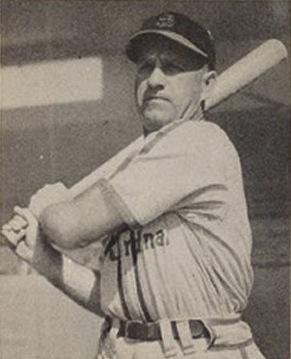
Enos Bradsher Slaughter, nicknamed "Country", was an American Major League Baseball (MLB) right fielder. He played for 19 seasons on four major league teams from 1938 to 1942 and 1946 to 1959. He is noted primarily for his playing for the St. Louis Cardinals and famously scored the winning run in Game 7 of the 1946 World Series for the Cardinals. A ten-time All-Star, he has been elected to both the National Baseball Hall of Fame and St. Louis Cardinals Hall of Fame.
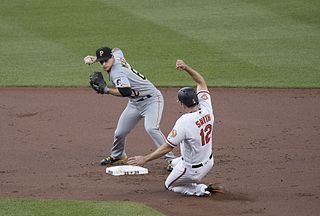
In baseball and softball, a double play is the act of making two outs during the same continuous play. Double plays can occur any time there is at least one baserunner and fewer than two outs.

Dominic Paul DiMaggio, nicknamed "the Little Professor", was an American Major League Baseball center fielder. He played his entire 11-year baseball career for the Boston Red Sox (1940–1953). DiMaggio was the youngest of three brothers who each became major league center fielders, the others being Joe and Vince.

John Michael Pesky, nicknamed "the Needle" and "Mr. Red Sox", was an American professional baseball player, manager and coach. He was a shortstop and third baseman during a ten-year major league playing career, appearing in 1,270 games played in 1942 and from 1946 to 1954 for three teams. He missed the 1943–45 seasons while serving in World War II. Pesky was associated with the Boston Red Sox for 61 of his 73 years in baseball—from 1940 through June 3, 1952, 1961 through 1964, and from 1969 until his death. Pesky also managed the Red Sox from 1963 to 1964, and in September 1980.

The 2004 World Series was the championship series of Major League Baseball's (MLB) 2004 season. The 100th edition of the World Series, it was a best-of-seven playoff between the American League (AL) champion Boston Red Sox and the National League (NL) champion St. Louis Cardinals; the Red Sox swept the Cardinals in four games. The series was played from October 23 to 27, 2004, at Fenway Park and Busch Memorial Stadium, broadcast on Fox, and watched by an average of just under 25.5 million viewers. The Red Sox's World Series championship was their first since 1918, ending the Curse of the Bambino.
The 1946 World Series was played in October 1946 between the St. Louis Cardinals and the Boston Red Sox. This was the Red Sox's first appearance in a World Series since their championship of 1918.
The 1942 World Series featured the defending champion New York Yankees against the St. Louis Cardinals, with the Cardinals winning the Series in five games for their first championship since 1934 and their fourth overall.

Harry William Walker was an American professional baseball player, coach and manager. Known by the nickname "Harry the Hat", he played as a center fielder in Major League Baseball between 1940 and 1955, most notably as a member of the St. Louis Cardinals with whom he won two world championships and was the 1947 National League batting champion.

George Michael "Catfish" Metkovich was an American outfielder and first baseman in Major League Baseball for the Boston Red Sox (1943–46), Cleveland Indians (1947), Chicago White Sox (1949), Pittsburgh Pirates (1951–53), Chicago Cubs (1953) and Milwaukee Braves (1954). Born in Angels Camp, California, to Croatian parents, Metkovich earned his nickname when he stepped on a catfish during a fishing trip and cut his foot; the injury and ensuing infection caused him to miss several games.
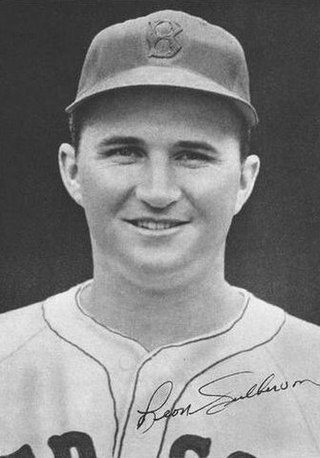
Delbert Leon Culberson was an American professional baseball player. He played as an outfielder in Major League Baseball (MLB) from 1943 to 1948 for the Boston Red Sox and the Washington Senators. Listed at 5 feet 11 inches (1.80 m) and 180 pounds (82 kg), he both batted and threw right-handed.

Robert Harold Klinger was a professional baseball player who was a right-handed pitcher in Major League Baseball over parts of eight seasons from 1938 through 1947. He played for the Pittsburgh Pirates and the Boston Red Sox. In 265 career appearances he compiled a 66–61 record along with 23 saves, with a 3.68 earned run average and 357 strikeouts. His cousin Charlie Hollocher was also a Major League Baseball player.
The 1946 St. Louis Cardinals season was a season in American baseball. It was the team's 65th season in St. Louis, Missouri and their 55th season in the National League. The Cardinals went 96–58 during the championship season and finished tied with the Brooklyn Dodgers for first in the National League. St. Louis then won a best-of-three playoff for the pennant, two games to none. In the World Series, they won in seven games over the Boston Red Sox. They won on Enos Slaughter's "mad dash" that gave them a 4–3 lead in the eighth inning of game 7.
The 1946 Boston Red Sox season was the 46th season in the franchise's Major League Baseball history. The Red Sox finished first in the American League (AL) with a record of 104 wins and 50 losses. This was the team's sixth AL championship, and their first since 1918. In the 1946 World Series, the Red Sox lost to the National League (NL) champion St. Louis Cardinals, whose winning run in the seventh game was scored on Enos Slaughter's famous "Mad Dash".
The 1949 Major League Baseball season was contested from April 18 through October 15, 1949. Both the American League (AL) and National League (NL) had eight teams, with each team playing a 154-game schedule. The New York Yankees won the World Series over the Brooklyn Dodgers in five games. Ted Williams of the Boston Red Sox and Jackie Robinson of the Dodgers won the Most Valuable Player Award in the AL and NL, respectively.

The 1941 Major League Baseball All-Star Game was the ninth playing of the mid-summer classic between the all-stars of the American League (AL) and National League (NL), the two leagues comprising Major League Baseball. The game was held on July 8, 1941, at Briggs Stadium in Detroit, Michigan, the home of the Detroit Tigers of the American League.
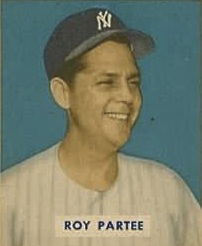
Roy Robert Partee was a Major League Baseball catcher. Listed at 5 ft 10 in (1.78 m), 180 lb (82 kg), Partee was nicknamed the "Little Round Man." He is likely best remembered as the man behind the plate for Enos Slaughter's "mad dash" in game seven of the 1946 World Series and as the New York Mets scout responsible for signing Bud Harrelson, Tug McGraw, Rick Aguilera and Greg Jeffries, among others.

The 1946 Major League Baseball All-Star Game was the 13th playing of the "Midsummer Classic" by Major League Baseball's (MLB) American League (AL) and National League (NL) All-Star teams.
The 1947 Major League Baseball All-Star Game was the 14th playing of the "Midsummer Classic" between Major League Baseball's (MLB) American League (AL) and National League (NL) All-Star teams. The All-Star Game was held on July 8, 1947, at Wrigley Field in Chicago, the home of the NL's Chicago Cubs.
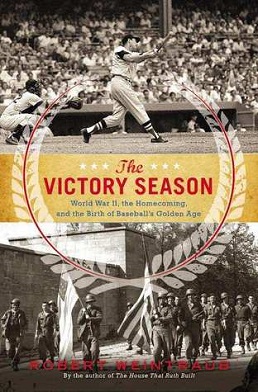
The Victory Season: The End of World War II and the Birth of Baseball's Golden Age is a 2013 book written by Robert Weintraub whose previous work includes the New York Times best-sellerThe House That Ruth Built.

Dugout to Foxhole: Interviews with Baseball Players Whose Careers Were Affected by World War II is a 1994 book written by Rick Van Blair. The book has been cited as a reference source for other baseball books.